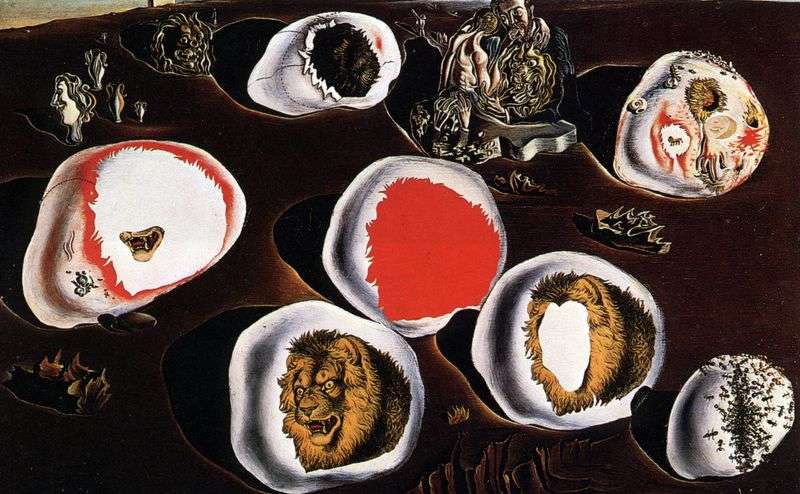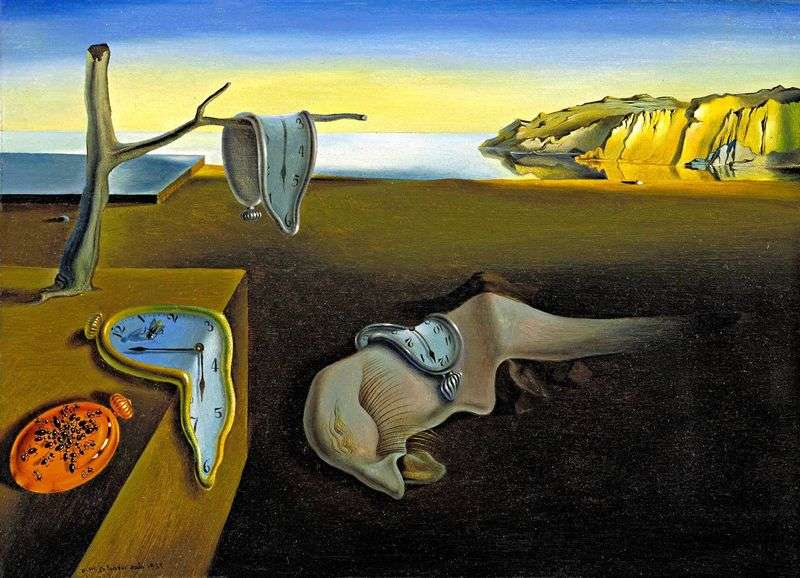
The work of Salvador Dali “The adaptability of desires” is another example of a frighteningly-attractive painting of the artist. Passion for the dismemberment of details into small parts is offered here as a delicious dish of cocoon-like spheres. A juicy substrate with a sugary watermelon palette hints at the presence of something bloody and sinister.
Despite the absence of obvious signs of sexual overtones, the canvas contains a veiled symbolism of relations – the naked torso of a woman feeding a head of a gigantic man. As in many other works in Desire, Dali turned to the theme of the frailty of everything on earth. As a symbol of decomposition and decay into parts, he used an ant swarm and analysis of the components of the lion’s head, the image of which appears in many Salvadorian canvases.
The presented picture is akin to a vivid illustration depicting jumps from cobblestone to cobblestone of different variations of a lion. In this interpretation, lion’s power can be regarded as a frenzy of desires. His various images – mane, mouth and silhouette, – fragments of desires. So the desires of people adapt to reality, and as a result, only a piece of its whole remains, for example, only manes or silhouettes. The stone-sphere with the image of either a snail or shells of a mollusc remains an unintelligible one. Presumably the snail is the personification of the mind, wisdom and just the human brain.
This interpretation is quite appropriate because of the trembling attitude of Salvador to the works of Freud, whose brain the surrealist compared with the shell of a snail: until you get to the truth – you will pass more than one turn. Then follows the untranslatable game of images from separately standing heads, like the rudiments of certain ideas. A poor fellow, clasping his head with his hands, apparently got to the bottom of the truth and realized the futility of his attempts to get what he wanted.
The work is juicy, airless with sharp shadows and unlimited space. “The adaptability of desires” is a canvas of Dali’s early works. His writing coincided with the author’s final conviction that he is a true surrealist, about which Dali will declare after 7 years with the words: “Surrealism is me”.
 Birth of fluid desires by Salvador Dali
Birth of fluid desires by Salvador Dali Persistence of memory by Salvador Dali
Persistence of memory by Salvador Dali Consistency of memory by Salvador Dali
Consistency of memory by Salvador Dali Sleep (Sleeping) by Salvador Dali
Sleep (Sleeping) by Salvador Dali The Temptation of Saint Anthony by Salvador Dali
The Temptation of Saint Anthony by Salvador Dali Sistine Madonna by Salvador Dali
Sistine Madonna by Salvador Dali The Crucifixion by Salvador Dali
The Crucifixion by Salvador Dali Giraffe in the fire by Salvador Dali
Giraffe in the fire by Salvador Dali